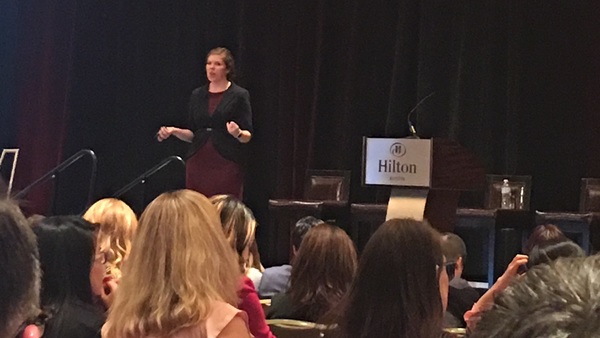 Lauren Culp, manager of The Cooperative Trust, delivers a speech on millennial engagement.
Lauren Culp, manager of The Cooperative Trust, delivers a speech on millennial engagement.AUSTIN, TEXAS – That group of people everyone is sick of hearing about – millennials – and the application of AI in driverless vehicles were two hot topics at the Filene Research Institute’s big. bright. minds. conference Thursday. Here are some key takeaways from the first day of the conference, held at the Hilton Austin in downtown Austin, Texas.
Driverless Vehicles Are Coming
When the use of driverless vehicles becomes widespread, the change won’t just disrupt the auto lending market – it’ll disrupt society as we know it. The cost of insurance will go down as fewer crashes take place on the road, the DMV may no longer be needed as driver’s licenses become unnecessary, and there will be no parking lots, no traffic policing and no need for local mechanics, Hope Schau explained in her presentation. Schau is a Filene fellow and professor of marketing at the University of Arizona.
Kids will take driverless buses designed to hold six to eight people to school and receive door-to-door service, helping them to avoid predators and accidents while crossing the street, she continued. And when they turn 16, the milestone of receiving their driver’s license will no longer exist. Driverless vehicles will take away jobs from truck drivers, impact the construction and farming industries as people will no longer be driving the machines, and even affect the advertising industry once commercials featuring cars are no longer relevant.
The most important change driverless vehicles will bring for big. bright. minds. attendees, however, is the change to the consumer demand for auto loans. So what can credit unions do to prepare? Schau said she didn’t have the answer to this question, but had a few suggestions for what they should begin considering.
“We need to think about shared ownership,” she said. “We need to think about ride share loans – what would that look like? If someone is going to drop $10,000 a year on ride shares, how can we finance that? What about insurance loans?”
Millennials: Like Them or Not, You Need Them
Lauren Culp, manager of The Cooperative Trust for Filene, likened a credit union’s efforts to woo millennials to skydiving. She said just as a skydiver’s failure to pull the ripcord could kill them, a credit union’s failure to actively engage millennials could drive it out of business.
In her presentation, Culp pointed out that 20% of a credit union’s members typically drive 150% of its income, with the other 80% costing the credit union money. With millennials now entering a wealth accumulation phase of their lives, credit unions must start marketing “grown up” products to them, like mortgages.
“We do value people over profit, but we still have to keep our doors open,” Culp said.
Culp offered three takeaways for credit unions looking to successfully engage millennial members, employees and leaders:
1. Don’t pay attention to the conflicting anecdotes and stereotypes out there in the news about millennials. Instead, figure out who “your” millennial members, talent and leaders are.
2. Instead of talking about millennials, invite them to join to conversation. Offer a platform where they can speak on their own behalf.
3. Don’t allow decisions to be made at your credit union within a homogeneous group. Work to develop millennial talent at your credit union, and expect them to develop you, too.
She added efforts to engage millennials must be ongoing. “It’s not a one-time project – it’s a habit.”


